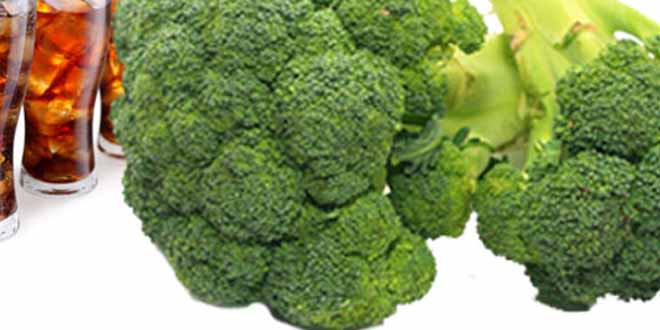
Is One Calorie from Soda the Same as One Calorie from Broccoli?
High calories are often thought of as the enemy for those watching their waistline. Everyone believes that the key to weight loss is to burn more calories than you consume, right? So does that mean that all calories are created equal? In other words, is 1 calorie from a soft drink the same as 1 calorie from, let’s say, broccoli ? Let’s find out.
Calories are, in other words, a unit of energy. If you notice on nutrition labels, the number of calories listed reflect the amount of potential energy a food contains that can be used by the body, in terms of kj or kilojoules. This amount of energy is used by the body to for it to keep functioning. When there is excess energy (calories), it is stored as body fat. In this way, whether they come from fats, carbs or protein, all calories really are created equal. One gram of protein contains four calories and it’s the same for carbs, but fat contains nine calories per one gram.
However, the body is much more complex than just determining numbers, with biological processes and different organs playing a role in absorbing and utilizing calories (as energy) differently from these sources. The origin of a calorie determines how the body digests and stores that energy. For example, calories from protein help rebuild damaged tissue and muscles and creates certain hormones and enzymes. Carbohydrates are a major energy source for the body, while fats both help protect organs and help with the absorption of important vitamins. All three nutrients are essential, but the body metabolizes them very differently.
Scientific Based Reasoning
Research has played a role in determining whether both quantity as well as the quality of calories matter for weight loss (or weight gain if you must). It has concluded that the quality of calories should be considered as more priority.
Let’s take a look at that soda and broccoli example. Suppose you have 750 calories of soda and 750 calories of broccoli. Refined sugars make up the bulk of the 750 calories of. It is 100 percent sugar containing 186 grams, or 46 teaspoons, of sugar. Fructose and glucose are the main sugars, and your gut quickly absorbs this. The glucose increases your blood sugar levels, which raises insulin levels and begins biochemical responses that should not occur. High insulin increases belly fat, inflammation raises triglycerides and lowers HDL (good cholesterol), and raises blood pressure. Insulin blocks leptin, which is a hormone that controls your appetite and thereby increases your appetite. This causes a resistance to leptin, so your brain never considers that you are full. Instead, it thinks you are still hungry. This in turn triggers your “reward center” of the brain, causing you to want to consume more sugar.
The fructose in the soda makes it worse. Fructose goes to your liver and starts producing fat, which triggers more resistance to insulin and storage of fat in your belly. This also results in a fatty liver, and more inflammation and inflammation causes more weight gain.
So these 750 calories from soda causes chaos in your body. What’s more is that soda contains no fiber, vitamins, minerals or phytonutrients to help you process the calories you are consuming. These are basically “empty calories” with no nutritional value.
Now let’s take a look at the 750 calories of broccoli. As with the soda, these calories are made up primarily, but not entirely, of carbohydrates. However, there is a difference between the carbohydrates found in soda and those found in broccoli.
Carbohydrates are plant-based compounds comprised of carbon, hydrogen, and oxygen. They come in many varieties, but they are all technically sugars or starches, which convert to sugar in the body. The important difference is in how they affect your blood sugar. High-fiber, low-sugar carbohydrates such as broccoli are slowly digested and don’t lead to blood sugar and insulin spikes, while table sugar and bread are quickly digested carbs that spike your blood sugar.
Those 750 calories of broccoli make up 21 cups and contain 67 grams of fiber (the average consumption is only 10 to 15 grams of fiber a day). Broccoli is 23 percent protein, 9 percent fat, and 68 percent carbohydrate, or 510 calories from carbs. The sugar in 21 cups of broccoli is the equivalent of only 1.5 teaspoons; the rest of the carbohydrates are the low-glycemic type found in all non-starchy vegetables, which are very slowly absorbed.
Based on just this bit of nutritional info, you can see that 750 calories in broccoli are not the same as the 750 calories in soda. The fiber in broccoli is absorbed and digested much slower in your body, so you would feel full and feel full for longer. There’d be no blood sugar or insulin spike, no fatty liver, no chaos. Your stomach sends signals to your brain that you are full. There would be no triggering of the addiction reward center in the brain. You’d also get many extra benefits that optimize metabolism, lower cholesterol, reduce inflammation, and boost detoxification. The phytonutrients in broccoli boost your liver’s ability to detoxify environmental chemicals, and some flavonoids are powerful anti-inflammatories. Broccoli also contains high levels of vitamin C and folate, which protect against cancer and heart disease.
The Bottom Line
Calories themselves are created equal, because scientifically they burn the same way, but the body treats them very differently. Some calories are addictive, others healing, some fattening, some metabolism-boosting. The right amount of calories from protein, carbs, and fat ensure the body functions properly and achieve long-lasting weight loss.

